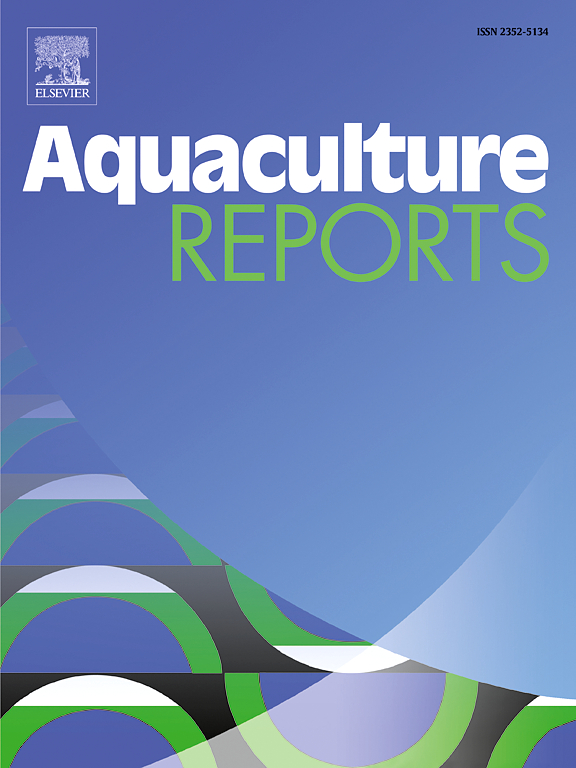饲粮中添加绿原酸减轻组胺应激下美洲鳗鲡幼鳗肠道损伤
IF 3.7
2区 农林科学
Q1 FISHERIES
引用次数: 0
摘要
鳗鱼(安圭拉属)是肉食性鱼类,对蛋白质的需求很高。鳗鱼水产养殖的一个主要挑战是使用低成本的红鱼粉,由于其高组胺含量,导致鳗鱼生长缓慢,免疫力降低和肠道损伤,因此不适合作为白鱼粉的替代品。绿原酸(CGA)是一种具有抗氧化和抗炎特性的天然多酚,在啮齿动物和猪的研究中显示,它可以增强肠道屏障的完整性,减少肠道炎症,促进生长。本研究以中国主要水产养殖品种美洲鳗鲡(Anguilla rostrata)幼鳗为实验模型。选取初始体重为14.33 ± 0.57 g的幼鳗264条,随机分为4个处理组:CON(对照组,基础饲料)、H(基础饲料+ 650 mg/kg组胺)、H + CGA200 (H + 200 mg/kg CGA)和H + CGA600 (H + 600 mg/kg CGA)。结果表明,与H组相比,添加CGA组的生长性能(FBW、WGR、SGR、FR)和血清免疫指标(IgM、C3)均有显著提高(P <; 0.05)。肠道健康评估显示,CGA抑制组胺诱导应激下组胺受体基因hrh1的表达(P <; 0.05),降低促炎基因NF-κB、IL-6、TNF-α、IFN-γ的表达(P <; 0.05),提高肠道蛋白酶和脂肪酶的活性(P <; 0.05)。此外,CGA改善了肠道形态,调节了肠道菌群结构,增加了有益菌丰度(P <; 0.05)。综上所述,200 mg/kg CGA可减轻鱼粉中高组胺含量对鳗鱼生长、肠道健康和免疫功能的负面影响,可作为红鱼粉添加剂,降低养殖成本。本文章由计算机程序翻译,如有差异,请以英文原文为准。
Dietary chlorogenic acid supplementation to alleviate intestinal damage in juvenile American eel (Anguilla rostrata) under histamine stress
Eels (Anguilla spp.) are carnivorous fish with high protein requirements. A major challenge in eel aquaculture is the use of low-cost red fishmeal, which, due to its high histamine content, causes slow growth, reduced immunity and intestinal damage in eels, rendering it unsuitable as a replacement for white fishmeal. Chlorogenic acid (CGA), a natural polyphenol with antioxidant and anti-inflammatory properties, has been shown in rodent and pig studies to enhance gut barrier integrity, reduce intestinal inflammation, and promote growth. This study utilized the juvenile American eel (Anguilla rostrata), a major aquaculture species in China, as the experimental model. A total of 264 juvenile eels (initial weight: 14.33 ± 0.57 g) were randomly assigned to four treatment groups: CON (control, basal diet), H (basal diet + 650 mg/kg histamine), H + CGA200 (H + 200 mg/kg CGA), and H + CGA600 (H + 600 mg/kg CGA). The results indicated that compared to the H group, the CGA supplementation groups exhibited significantly improved growth performance (FBW, WGR, SGR, FR) and serum immune parameters (IgM, C3) (P < 0.05). Intestinal health assessments revealed that CGA suppressed the expression of histamine receptor gene hrh1 under histamine-induced stress (P < 0.05), reduced the expression of pro-inflammatory genes (NF-κB, IL-6, TNF-α, IFN-γ) (P < 0.05), and increased the activity of intestinal protease and lipase (P < 0.05). Furthermore, CGA improved intestinal morphology, modulated the gut microbiota structure, and increased the abundance of beneficial bacteria (P < 0.05). These findings suggest that 200 mg/kg CGA can mitigate the negative effects of high histamine in fishmeal on eel growth, intestinal health and Immune function, could be used as an additive in red fishmeal to reduce aquaculture costs.
求助全文
通过发布文献求助,成功后即可免费获取论文全文。
去求助
来源期刊

Aquaculture Reports
Agricultural and Biological Sciences-Animal Science and Zoology
CiteScore
5.90
自引率
8.10%
发文量
469
审稿时长
77 days
期刊介绍:
Aquaculture Reports will publish original research papers and reviews documenting outstanding science with a regional context and focus, answering the need for high quality information on novel species, systems and regions in emerging areas of aquaculture research and development, such as integrated multi-trophic aquaculture, urban aquaculture, ornamental, unfed aquaculture, offshore aquaculture and others. Papers having industry research as priority and encompassing product development research or current industry practice are encouraged.
 求助内容:
求助内容: 应助结果提醒方式:
应助结果提醒方式:


